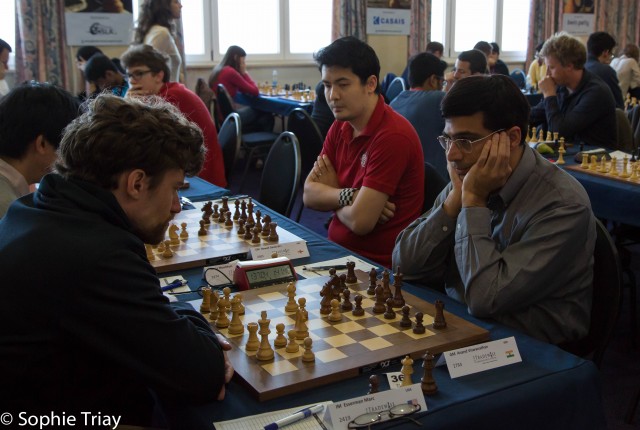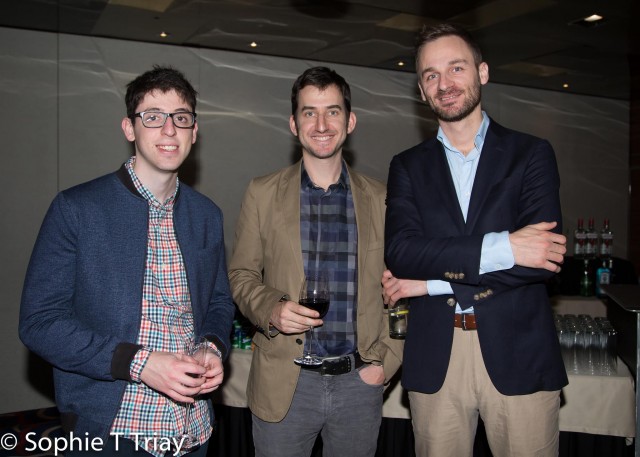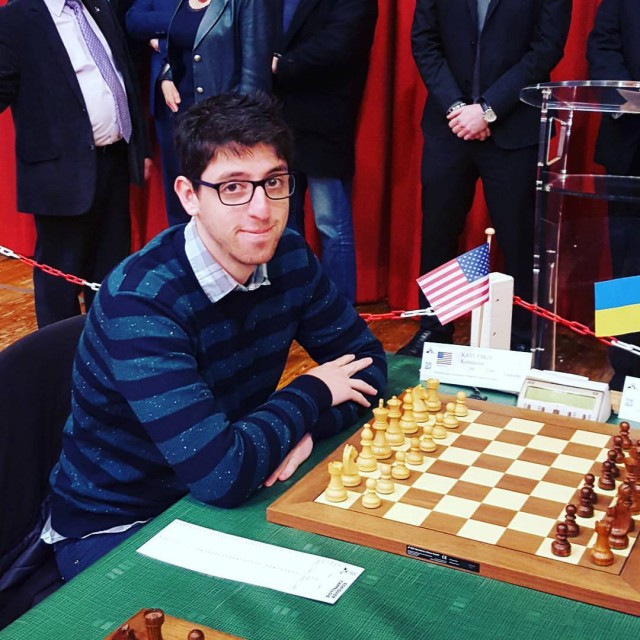 “If I don’t get my last norm on this trip it will be nothing but an utter failure,” I joked, half-seriously, to my roommate and travel partner, Tom Riccardi. “Okay just kidding--the experience will be totally worth it, of course, no matter how I do,” I added, wisely lowering the expectations. I often lecture about the importance of not pinning your happiness to your results, to aim to enjoy the moment and the process and to be satisfied with trying your best. My two-month trip to Europe, somewhat unfortunately, gave me the golden opportunity to practice what I preach. I only had one real goal, to earn my third and final IM norm, and four tries to make it happen.
The trip came about spontaneously. Despite playing alongside each other in a few national championships when we were much younger and much less aware of the infinite stresses of chess, Tom and I never actually met or spoke until about a year ago, when we ran into each other at a blitz tournament held at the historic Mechanics Chess Club in San Francisco. A few weeks later Tom messaged me and we started studying together. He was planning to go to dental school in Fall of 2016 and wanted to play as much chess as possible before then, to see how far he could go. Thus he wanted to travel, perhaps to Europe, and play in a series of high-level chess tournaments. And me, pining to play in Europe for a few years now, finally felt confident enough to make the jump; so we started planning the trip last summer. As luck would have it, we were also both seeking a place to live in Santa Clara County (aka the South Bay), and so we moved in together in Mountain View and setup a permanent chessboard in our living room.
“If I don’t get my last norm on this trip it will be nothing but an utter failure,” I joked, half-seriously, to my roommate and travel partner, Tom Riccardi. “Okay just kidding--the experience will be totally worth it, of course, no matter how I do,” I added, wisely lowering the expectations. I often lecture about the importance of not pinning your happiness to your results, to aim to enjoy the moment and the process and to be satisfied with trying your best. My two-month trip to Europe, somewhat unfortunately, gave me the golden opportunity to practice what I preach. I only had one real goal, to earn my third and final IM norm, and four tries to make it happen.
The trip came about spontaneously. Despite playing alongside each other in a few national championships when we were much younger and much less aware of the infinite stresses of chess, Tom and I never actually met or spoke until about a year ago, when we ran into each other at a blitz tournament held at the historic Mechanics Chess Club in San Francisco. A few weeks later Tom messaged me and we started studying together. He was planning to go to dental school in Fall of 2016 and wanted to play as much chess as possible before then, to see how far he could go. Thus he wanted to travel, perhaps to Europe, and play in a series of high-level chess tournaments. And me, pining to play in Europe for a few years now, finally felt confident enough to make the jump; so we started planning the trip last summer. As luck would have it, we were also both seeking a place to live in Santa Clara County (aka the South Bay), and so we moved in together in Mountain View and setup a permanent chessboard in our living room.
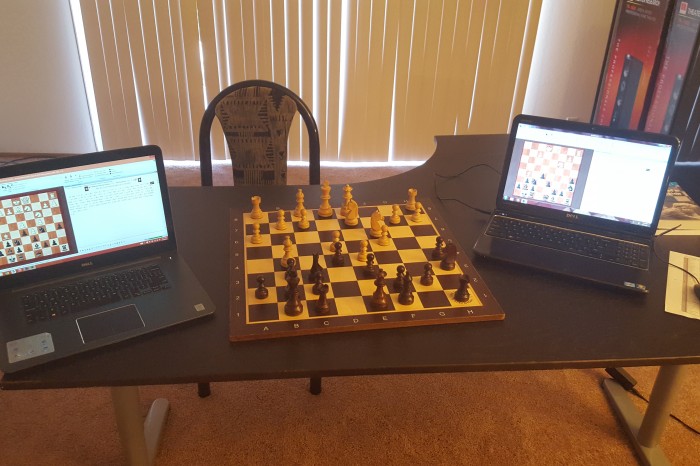 We quickly figured out that the marquee tournaments were the Gibraltar Chess Festival at the end of January and the Reykjavik Open in March. Searching for events in between, we eventually stumbled upon two tournaments in France: the Cappelle-la-Grande Open and the Cannes Chess Festival, both expected to have quite a strong turnout. Much to our surprise, however, by October of 2015 the Gibraltar Open was already full! They reached their cap of about 250 players and had quite a few on the waitlist as well.
So we planned our trip to start in Cappelle and finish in Reyjkavik. Then, at the beginning of January earlier this year, with our flights already booked, I got an email from GM Stuart Conquest, the director of the Gibraltar Chess Festival, who asked if I could still make the tournament, as a spot had opened up. I forwarded the email to Tom, adding a four-letter expletive in all-caps. I had already prepared, mentally, emotionally, and financially to start the trip in France. It would be such a burden to change everything around and prepare myself to actually make it and play Gibraltar. But passing up the opportunity to play in Gibraltar was simply not an option; it felt a bit like destiny, honestly speaking. So I hustled and altered my travel plans, booked a new flight and an Airbnb in Gibraltar and Paris, where I would stay for a week and meet up with Tom before heading north to Cappelle-la-Grande.
Finally the dream trip was set, and I couldn’t have been more excited. I had no reason not to be confident, I had spent the last six months really training seriously and my previous tournament, the 2015 North American Open, earned me my second IM norm. But I was also scared, genuinely, of failing. I went back and forth, from confidence to fear. Eventually I landed upon the philosophy that since my eventual goal is to become a Grandmaster anyway, then while getting the final IM norm would be wonderful and amazing and deeply fulfilling, it was just a step of a much longer journey, so it wouldn’t matter all that much in the long run if/when I achieved this goal. With my mind and spirit at ease I embarked on my journey.
Gibraltar Chess Festival
The U.K. territory just south of Spain was warm and delightful, with the gorgeous rock of Gibraltar visible from any point in the city. If I had to choose a favorite tournament this would be it. Impeccably organized, ridiculously strong, and overall a great experience. I loved playing in the main room, surrounded by so many brilliant players: Anand, Short, Kamsky, Nakamura, MVL…I mean you couldn’t throw a rock (pun intended) and not hit a 2700 super-GM.
My tournament started out without any hits or misses, I won in Round 1 playing down against an American, Edward Sedillo (my last game in Europe was also to be against an American, but I played zero in between!). Then in Round 2 I lost to GM Bela Khotenashvili (Georgia), one of the strongest female players in the world, despite at one point having an excellent position. In Round 3 I was again paired down and won against Henrik Lobersli of Norway (I would face Henrik once more in the Reykjavik Open) and in Round 4 I again faced one of the strongest female players in the world, GM Valentina Gunina (Russia), who got the better of me in a very complex game. 2/4 was nothing to be shy about, as I felt I had played fairly reasonably up to that point. Then I won so, so undeservedly in Round 5:
We quickly figured out that the marquee tournaments were the Gibraltar Chess Festival at the end of January and the Reykjavik Open in March. Searching for events in between, we eventually stumbled upon two tournaments in France: the Cappelle-la-Grande Open and the Cannes Chess Festival, both expected to have quite a strong turnout. Much to our surprise, however, by October of 2015 the Gibraltar Open was already full! They reached their cap of about 250 players and had quite a few on the waitlist as well.
So we planned our trip to start in Cappelle and finish in Reyjkavik. Then, at the beginning of January earlier this year, with our flights already booked, I got an email from GM Stuart Conquest, the director of the Gibraltar Chess Festival, who asked if I could still make the tournament, as a spot had opened up. I forwarded the email to Tom, adding a four-letter expletive in all-caps. I had already prepared, mentally, emotionally, and financially to start the trip in France. It would be such a burden to change everything around and prepare myself to actually make it and play Gibraltar. But passing up the opportunity to play in Gibraltar was simply not an option; it felt a bit like destiny, honestly speaking. So I hustled and altered my travel plans, booked a new flight and an Airbnb in Gibraltar and Paris, where I would stay for a week and meet up with Tom before heading north to Cappelle-la-Grande.
Finally the dream trip was set, and I couldn’t have been more excited. I had no reason not to be confident, I had spent the last six months really training seriously and my previous tournament, the 2015 North American Open, earned me my second IM norm. But I was also scared, genuinely, of failing. I went back and forth, from confidence to fear. Eventually I landed upon the philosophy that since my eventual goal is to become a Grandmaster anyway, then while getting the final IM norm would be wonderful and amazing and deeply fulfilling, it was just a step of a much longer journey, so it wouldn’t matter all that much in the long run if/when I achieved this goal. With my mind and spirit at ease I embarked on my journey.
Gibraltar Chess Festival
The U.K. territory just south of Spain was warm and delightful, with the gorgeous rock of Gibraltar visible from any point in the city. If I had to choose a favorite tournament this would be it. Impeccably organized, ridiculously strong, and overall a great experience. I loved playing in the main room, surrounded by so many brilliant players: Anand, Short, Kamsky, Nakamura, MVL…I mean you couldn’t throw a rock (pun intended) and not hit a 2700 super-GM.
My tournament started out without any hits or misses, I won in Round 1 playing down against an American, Edward Sedillo (my last game in Europe was also to be against an American, but I played zero in between!). Then in Round 2 I lost to GM Bela Khotenashvili (Georgia), one of the strongest female players in the world, despite at one point having an excellent position. In Round 3 I was again paired down and won against Henrik Lobersli of Norway (I would face Henrik once more in the Reykjavik Open) and in Round 4 I again faced one of the strongest female players in the world, GM Valentina Gunina (Russia), who got the better of me in a very complex game. 2/4 was nothing to be shy about, as I felt I had played fairly reasonably up to that point. Then I won so, so undeservedly in Round 5:
Alistair Hill vs. Kostya Kavutskiy
White to move.
In the diagrammed position I had just played Nd6, hoping for Qc6, so I could play Rc8 and trap White’s queen. My opponent saw the same simple trap, and quickly retreated with Qb2. Neither he nor I noticed that after Qc6 Rc8 the knight on d6 is unprotected (!) and Qxd6 would decide matters on the spot. Call it whatever you’d like, mutual blindness, divine providence, sheer dumb luck, I eventually won the game and blissfully tweeted about it. In Round 6 I finally got my big break. I was paired against another Norwegian, IM Johan Salomon, who I managed to outplay towards the end of the first time control, allowing me to win a nice game:[pgn]
[Event "Gibraltar Masters 2016"]
[Site "?"]
[Date "2016.01.31"]
[Round "6"]
[White "Kavutskiy, Kostya"]
[Black "Salomon, Johan"]
[Result "1-0"]
[ECO "A91"]
[WhiteElo "2360"]
[BlackElo "2444"]
[Annotator "Kostya Kavutskiy"]
[PlyCount "113"]
[EventDate "2016.??.??"]
1. d4 e6 2. c4 f5 3. g3 Nf6 4. Bg2 c6 5. Nd2 d5 6. Nh3 Be7 7. Qc2 O-O 8. O-O
Na6 9. a3 Ne4 10. f3 Nxd2 11. Bxd2 Bf6 12. cxd5 cxd5 13. e3 Qb6 14. Bc3 Bd7 15.
Nf4 Rac8 16. Rfe1 Rfe8 17. Qd2 Nb8 18. Nd3 Qd8 19. e4 fxe4 20. fxe4 dxe4 21.
Nc5 Bc6 22. Nxe4 Bd5 23. Qf4 Rf8 24. Qg4 Nc6 25. Rad1 b6 26. Rf1 Kh8 $6 {The
start of Black's troubles. I felt 26...Rc7 was better.} 27. Nxf6 gxf6 (27...
Rxf6 28. Rxf6 Qxf6 29. Bxd5 $18 {and the rook on c8 is hanging.}) 28. Rde1 $1
Bxg2 ({Stockfish gives} 28... f5 {but this is a strange move for a human to
play, at least to my eyes.}) 29. Kxg2 Qd5+ 30. Qe4 $16 {Black's e- and f-pawns
are serious weaknesses.} Kg7 31. Qxd5 exd5 32. Rf5 Rcd8 33. Re6 Na5 34. Bb4 $1
{The bishop is heading to e7.} Rfe8 35. Rexf6 Rd7 $2 {Black defends the 7th
rank, but gives up the 8th!} (35... Nc4 $1 36. Rf2 $16) 36. Bf8+ Rxf8 (36...
Kh8 37. Bh6 $1 Rdd8 38. Rf7 $18 {is hopeless.}) 37. Rxf8 Nc6 {I almost played
Rc8 here! ...but noticed Ne7 at the last second and dragged my hand back.} 38.
Re8 Nxd4 39. Rff8 Ne6 40. Rf1 Nc7 {Now that the time control has been reached,
White is easily winning, as the knight lacks a good square and there are many
open files for White's rooks to use.} 41. Re5 d4 {Here I calculated until the
end of the game:} 42. Rd1 Kf6 43. Re4 Ne6 44. Rf1+ Ke7 45. Rfe1 Rd6 46. Kf3 d3
47. Rxe6+ Rxe6 48. Rxe6+ Kxe6 49. Ke3 Kf5 50. h3 $1 {This and the resulting
position had to be seen far in advance. Fortunately I had plenty of time to
work it all out.} d2 51. Kxd2 Ke4 52. Ke2 {The activity of Black's king is
only temporary, White will shuffle Ke2-f2 as needed until Black runs out of
pawn moves.} b5 53. b4 Kd4 54. g4 Ke4 55. Kf2 Kf4 56. Kg2 a6 57. Kf2 1-0[/pgn]
Now thoughts of getting that norm started swimming around in my head. In my next two games I drew against grandmasters Florian Handke of Germany and G.N. Gopal of India. While on paper that’s an excellent result, especially for someone chasing the norm, I felt very disappointed to miss several wins against GM Handke:
[pgn]
[Event "Gibraltar Masters 2016"]
[Site "?"]
[Date "2016.02.01"]
[Round "7"]
[White "Handke, Florian"]
[Black "Kavutskiy, Kostya"]
[Result "1/2-1/2"]
[ECO "A48"]
[WhiteElo "2533"]
[BlackElo "2360"]
[Annotator "Kostya Kavutskiy"]
[PlyCount "83"]
[EventDate "2016.??.??"]
1. d4 Nf6 2. Bf4 g6 3. e3 Bg7 4. h3 d6 5. Nf3 O-O 6. Be2 c5 7. O-O b6 8. c3 Bb7
9. Nbd2 Nbd7 10. Bh2 Ne4 11. Nxe4 Bxe4 12. d5 Bxf3 13. Bxf3 b5 $1 {I felt very
comfortable here, Black has an easy game on the queenside. Objectively it
should be close to equal though.} 14. Qd2 c4 15. Bd1 Nc5 16. Bc2 Qb6 17. e4
Rab8 18. a3 a5 19. Qe2 Nd7 20. Bf4 $1 Qc7 21. Be3 b4 22. axb4 axb4 23. Ra7 Rb7
24. Rxb7 Qxb7 25. Qxc4 bxc3 26. b4 $5 {Ambitious.} Ne5 27. Qb3 Qb5 28. Rb1 Rb8
29. Kh1 Nd7 30. f3 Ne5 31. Ba7 Rc8 32. Bg1 h5 33. Ra1 {Around here was the
critical moment, or critical series of moments, I should say. Black's passed
pawn is stronger, but is currently blockaded. White's b-pawn isn't going
anywhere just yet, but can become very strong if Black's queen is dislodged
from b5.} Qe2 $1 {In mutual time trouble I went for this sharp continuation,
feeling quite optimistic.} 34. b5 (34. Bd1 Qf1 35. Rb1 Nd3 $1 {and the threat
of Nf2+ or Ne1 is crushing.}) 34... Nxf3 $1 {The point. White's pieces are
busy with the c3-pawn to defend the kingside.} 35. Bd1 (35. b6 Nh4 $1 $19 {was
necessary for me to see in advance. My opponent admitted he didn't see this
resouce until it was too late.}) 35... Qb2 $6 {I played this quickly because I
had planned it beforehand, but I should have stopped and looked for
alternatives, at least for 30 seconds. I likely would have found a much
stronger, winning idea.} (35... Qe1 $1 {Or Qf1! And White is completely pinned
along the first rank. The threat is Bd4.} 36. Bxf3 (36. gxf3 Bd4 $19) 36...
Qxa1 $19) 36. Ra2 $1 {The only move. Fortunately Black is still close to
winning.} Qxb3 37. Bxb3 Nxg1 38. Kxg1 Rc5 39. Ba4 c2 $4 {I still shake my head
in total disbelief when looking at this position. What happened? I panicked. I
was so concerned with White's b-pawn that I forgot about the strength of my
own.} ({After the game my opponent pointed out} 39... Rc4 40. Bc2 Rb4 41. Bd3
Rd4 42. Bc2 {All this I saw, then thought I would need to repeat with Rb4, but.
..} Rd2 $19 {and White is just lost. The pin along the 2nd rank is permanent,
and Bd4 & Rf2 is coming next. Black can even win slowly by creating a second
passer on the kingside. White is completely helpless.}) 40. Rxc2 Rxc2 41. Bxc2
Bd4+ 42. Kf1 {Neither side can realistically win, so we agreed on a draw here,
still rushed with adrenaline from the recent time pressure.} 1/2-1/2[/pgn]
In Round 9 I’d be gifted with a serious chance of clinching not just the norm, but the title too, since my live rating had crossed 2400 by this point in the tournament. I was paired Black against yet another elite female player, WGM Tan Zhongyi (China). The morning of the game I went on a small hike with Mike Klein and Peter Doggers of Chess.com, who were at Gibraltar to run the official live-commentary broadcast. Normally I’d try to relax before such an important game, but I wouldn’t get another chance to climb the rock and appreciate the view, so enjoyment of nature trumped chess preparation in this one case.
 But despite losing the following game I don’t regret going on the hike at all, if anything it boosted my confidence—well see for yourself, I had a great position!
But despite losing the following game I don’t regret going on the hike at all, if anything it boosted my confidence—well see for yourself, I had a great position!
[pgn]
[Event "Gibraltar Masters 2016"]
[Site "?"]
[Date "2016.02.03"]
[Round "9"]
[White "Zhongyi, Tan"]
[Black "Kavutskiy, Kostya"]
[Result "1-0"]
[ECO "E91"]
[WhiteElo "2504"]
[BlackElo "2360"]
[Annotator "Kostya Kavutskiy"]
[PlyCount "97"]
[EventDate "2016.??.??"]
1. d4 Nf6 2. c4 g6 3. Nc3 Bg7 4. e4 d6 5. Be2 O-O 6. Bg5 Na6 7. Nf3 h6 8. Bf4
e5 9. dxe5 Nh5 10. Be3 dxe5 11. g3 c6 12. Qd2 Kh7 13. O-O-O Qe7 14. Qd6 {After
a bit of negotiation, we finally settle on the queen trade. White is happy to
seize the d-file, Black is happy to lure the White rook to d6, from where it
will eventually get hit with Bf8.} Qxd6 15. Rxd6 Re8 $1 {The idea is to play
Nf6-g4, and White cannot play respond with h3 as she has already pushed the
g-pawn. The other idea is Bf8-c5. I understood here that even though White
looks better developed, the structure gives more potential to Black's pieces.}
({The immediate} 15... Nf6 {is met with} 16. h3 $1 {Followed by g3-g4 and
White is better.}) 16. Rhd1 Nf6 $1 17. c5 ({Of course I had to see} 17. Rd8 $2
Rxd8 18. Rxd8 Nd7 $1 {and the rook is trapped.} 19. Re8 Nc7 20. Re7 Kg8 $19)
17... Nc7 {White is out of ideas and Ng4 is next. I think Black is already
playing for the advantage.} 18. Nd2 Ng4 19. Bxg4 Bxg4 20. f3 Be6 $15 {Next is
Bf8-e7, Na6, etc.} 21. Nb3 Bf8 22. R6d2 Na6 23. Na4 Nb4 24. Kb1 Be7 (24... b5
$6 {is good for White after} 25. cxb6 axb6 26. Nxb6 Rxa2 27. Nc5 $1 $16) 25.
Nc1 Red8 $6 {I hate myself for making this move. White's rooks clearly have
nothing to do on the d-file. Instead of trying to get closer to a draw, Black
should improve his position.} ({Better would have been anything, like} 25... f6
26. a3 Na6 27. Kc2 Nc7 {Followed by h5-h4, probing to make a weakness on the
kingside. Black's advantage is nothing special, but two bishops are two
bishops.}) 26. a3 Na6 27. Kc2 Rxd2+ 28. Rxd2 Rd8 $2 {Well this was the plan,
but again I should have realized that keeping a pair of rooks on the board can
only be good for Black, as the rook can support my eventual kingside play.} 29.
Rxd8 Bxd8 30. Nd3 f6 31. b4 {Now White is not worse at all, as she has easy
play on the queenside and the position is still fairly closed, which is good
for her knights.} Nc7 32. Nc3 Bc4 $2 {Trying to offer a repetition. Moronic.} (
32... h5 {followed by bringing the king to the center would have kept Black's
position perfectly safe.}) 33. Nb2 Be6 ({Even} 33... Bf1 {would be better, but
I was hoping she would repeat moves.}) 34. Kd3 $1 {Of course! White just
improves her position. I mean why not, clearly Black is content to just stay
put and not do anything. But now it's Black who needs to be careful, since the
threat of Nc4-d6 is quite serious.} Bh3 $6 {I had a few more solid ways to
play.} (34... Nb5 35. Nxb5 cxb5 36. Nd1 Kg7 37. Nc3 Bc4+ 38. Kd2 h5 39. Nd5 Kf7
$11) ({Simplest was probably} 34... h5 35. Nc4 Bxc4+ 36. Kxc4 Ne6 $11 {But I
wasn't ready to part with my light-squared bishop.}) 35. Nc4 $1 Ne8 ({The
point is} 35... Bf1+ 36. Ne2 Nb5 {wins a pawn for Black, but I realized in
time that this would end badly for me:} 37. a4 Bxe2+ 38. Kxe2 Nc3+ 39. Kd3 Nxa4
40. Nd6 b6 (40... b5 41. Nc8 $18) 41. Kc2 $1 $18 {and the knight on a4 is
trapped.}) 36. Nd6 Nxd6 37. cxd6 b6 {White's pawn on d6 is potentially both
weak and strong, depending on how the game develops. White's plan is to open
the queenside with a4 and b5.} 38. a4 Bf1+ 39. Kd2 Kg7 40. b5 {A critical
moment.} cxb5 {Not a losing move, but it makes Black's life difficult.} (40...
c5 41. Nd5 h5 42. Nc7 Kf7 43. a5 Bh3 44. Kc3 Bc8 $11 {I wasn't sure about a
position like this, though Stockfish says it holds, apparently.}) 41. Nxb5 Bxb5
42. axb5 h5 {The entire evaluation of this endgame depends on whether or not
Black can prevent White's king from getting to d5.} 43. f4 $1 {The only real
try.} ({Black should hoId after} 43. Kd3 Kf7 44. Bc1 ({Or} 44. Bh6 Ke6 45. Bf8
Kf7) 44... Ke6 45. Ba3 f5) 43... exf4 $4 {Losing. I should have spent more
time here, all of my time really. I would have discovered that Black has
nothing to fear after Kf7.} (43... Kf7 $1 44. f5 (44. fxe5 fxe5 45. Bh6 Ke6 46.
Bf8 Kf7 47. Bh6 Ke6 $11) 44... gxf5 45. exf5 Ke8 46. h4 Kd7 47. g4 Kxd6 48.
gxh5 {All this would have been more or less forced, and I assumed I was lost
here, since the h-pawns are strong and White's king has an easy path to
infiltrate. But things are not so clear:} Ke7 49. h6 Kf7 50. Kd3 Kg8 51. Ke4
Be7 $1 52. Kd5 Bc5 $1 {This is the resource I didn't find. I thought White's
king enters and it's over.} 53. Bd2 Bf2 54. h5 Kh7 $11 {And White cannot make
progress, since Kc6 is met with e4-e3.}) 44. gxf4 f5 (44... Kf7 45. f5 gxf5 46.
exf5 Ke8 47. Bf4 $18 {is over, as Black's bishop is completely dead.}) 45. e5
Kf7 {I thought I might be able to create some kind of blockade/fortress, but
my opponent quickly setup a fatal zugzwang.} 46. Bf2 {Threatening h2-h4, which
would kill Black's bishop and allow White's king to get to d5 (since Black's
king cannot stay on e6 forever).} g5 (46... h4 {was a better try, but White
has a win:} 47. h3 $1 g5 48. Ke3 Ke6 49. Kf3 Kd5 50. Be3 gxf4 51. Kxf4 Ke6 52.
Bf2 {and it's zugzwang, Black is lost.}) 47. h4 $1 {Seiling the fate of my
poor bishop.} (47. fxg5 $4 {would blow the win, as Black sets up a fortress
and avoids zugzwang.} Bxg5+ 48. Be3 Bh4 49. Kd3 Ke6 50. Bf4 Bd8 51. Kd4 Bh4 52.
d7 Bd8 $1 $11 {I was hoping for something like this, but it was not to be!} (
52... Kxd7 53. Kd5 $18)) 47... gxh4 ({If} 47... gxf4 {White just advances the
king and shuffles until Black runs out of moves.} 48. Kd3 Ke6 49. Kd4 f3 50.
Bg3 f4 51. Bf2 $18) 48. Ke2 $1 Ke6 49. Kf1 {In view of Kg2-h3 and Bxh4, I
resigned.} ({Of course not} 49. Kf3 $4 {when Black's bishop gets out:} h3 50.
Bg3 (50. Kg3 $4 Bh4+ $19) 50... Kd7 51. Bh2 Bh4 $11) 1-0[/pgn]
Honestly I’m still not over this one, even now, more than two months later. I can still close my eyes and I’m there, in Gibraltar, feeling swell, watching my norm hopes dwindle away move by move. All I can hope for now is to learn from the experience and never ever relax in a chess game until the clock is stopped, no matter what.
In the final round I could still earn the norm with a win over GM Pontus Carlsson (Sweden) but I wasn’t even close. Pontus outplayed me and won handedly. I blew it the round before.
During Round 1 of this event I ran into IM Marc Esserman--we’d met a few years before but never talked all that much. We exchanged our travel plans and found out we’d both be playing Cappelle-la-Grande, Cannes, and Reykjavik! Marc was already on an extended tour that included the London Chess Classic back in December of 2015. Like me, Marc was seeking a title (the grandmaster title), and like me, came oh so close. His event was nonetheless memorable, as he defeated Nigel Short and then drew Anand a few rounds later:
[pgn] [Event "Gibraltar Masters 2016"] [Date "2016.01.29"] [Round "4.26"] [White "Esserman, Marc"] [Black "Short, Nigel"] [Result "1-0"] [ECO "C07"] [WhiteElo "2419"] [BlackElo "2684"] [PlyCount "89"] [EventDate "2016.01.26"] 1. e4 e6 2. d4 d5 3. Nd2 a6 4. Bd3 c5 5. dxc5 Bxc5 6. Ngf3 Nc6 7. c3 Nge7 8. O-O O-O 9. Qe2 Ng6 10. Nb3 Ba7 11. Be3 Qd6 12. Rad1 Nf4 13. Qd2 Bxe3 14. Qxe3 Qc7 15. Bb1 f6 16. g3 dxe4 17. Qxe4 Ng6 18. h4 Rf7 19. h5 Nf8 20. Nbd4 Bd7 21. a3 Re8 22. Ba2 b5 23. Rfe1 Na5 24. Nd2 Nb7 25. Qf3 Nd6 26. Ne4 Nc4 27. b4 Nxa3 28. Nc5 Nc4 29. Bxc4 bxc4 30. Nxa6 Qc8 31. Nc5 h6 32. Qe2 e5 33. Nxd7 Rxd7 34. Nc2 Red8 35. Rxd7 Nxd7 36. Rd1 Nb6 37. Ne3 Rd7 38. Qg4 Rxd1+ 39. Qxd1 Qc7 40. Qg4 Qf7 41. Nf5 Kf8 42. Ne3 Ke8 43. Qe4 Qxh5 44. Qc6+ Nd7 45. g4 1-0[/pgn]
[pgn] [Event "Gibraltar Masters 2016"] [Date "2016.02.02"] [Round "8.36"] [White "Esserman, Marc"] [Black "Anand, Viswananthan"] [Result "1/2-1/2"] [ECO "B22"] [WhiteElo "2419"] [BlackElo "2784"] [PlyCount "45"] [EventDate "2016.01.26"] 1. e4 c5 2. d4 cxd4 3. c3 Nf6 4. e5 Nd5 5. Nf3 e6 6. cxd4 d6 7. Bc4 Nc6 8. O-O Be7 9. Qe2 O-O 10. Nc3 dxe5 11. dxe5 Nxc3 12. bxc3 Qc7 13. Qe4 Rd8 14. Re1 g6 15. Bg5 Bxg5 16. Nxg5 h6 17. Nf3 Qe7 18. h4 Na5 19. Bd3 Bd7 20. Nd4 Nc6 21. Nf3 Na5 22. Nd4 Nc6 23. Nf3 1/2-1/2[/pgn]Although in the end I finished with just 5/10, the experience was really invaluable, and the tournament had a great atmosphere. In addition to Marc I also ran into U.S. players FM Kazim Gulamali and FM Matt Herman, who, incidentally, did clinch his final IM norm and the title, beating GM Handke in the final round to boot, (congrats Matt)! Cappelle-la-Grande After Gibraltar I spent a week in Paris resting, enjoying the food, and contemplating life (so you know, the usual Parisian experience). I met up with Jason Stoneking, a Paris-based writer who I’ve worked with multiple times in the past doing commentary on Chess.com. We discussed chess, life, art, nihilism, among other things, and visited the Museum of Hunting and Nature, where they had way more taxidermy than I ever thought possible. A few days later Tom flew in, having never seen Paris before, so we spent an afternoon trying to cram in as many sights as possible. We saw the Arc de Triomphe, the Eiffel Tower, and the Louvre Museum. Then the next day we took a bus up to the northern tip of France, to Dunkirk, the larger town adjacent to Cappelle-la-Grande. Honestly I had the least amount of idea in terms of what to expect from this tournament. We even had to switch hotels at the last second but eventually found a good hotel near the town’s central bus stop, and would travel to the tournament hall daily.
 We were pleasantly surprised by the event, as despite having over 500 players in attendance the tournament went quite smoothly and the organization (as far as I could tell) ran extremely well. The field was not as star-studded as Gibraltar but nevertheless extremely deep in strength, with over 50 grandmasters, led by the top seed, Kamsky (who would go on to win clear first).
My tournament started out fruitfully as I drew against GM Andrey Vovk of Ukraine (my countryman!). But then followed a loss to GM Murtas Kazhgaleyev (Kazakhstan) and a draw playing down against Prasenjit Dutta (India). Due to the huge number of players and the hyper-accelerated pairings used by the tournament, I was relegated to playing down my next three rounds. I won all three, and got another crack at a top player, facing GM Tigran Gharamian (France). He duly trounced me, and I was back to playing down for the rest of the tournament, sans norm chances. I scored another win in Round 8, and had I converted a winning position in my last round game, I likely would’ve taken the top U2400 prize on tie-breaks. But it was not to be.
Tom, on the other hand, had an excellent tournament, scoring a few upsets and finishing with 5/9, which was good enough to take the top U2100 prize on tiebreaks.
We were pleasantly surprised by the event, as despite having over 500 players in attendance the tournament went quite smoothly and the organization (as far as I could tell) ran extremely well. The field was not as star-studded as Gibraltar but nevertheless extremely deep in strength, with over 50 grandmasters, led by the top seed, Kamsky (who would go on to win clear first).
My tournament started out fruitfully as I drew against GM Andrey Vovk of Ukraine (my countryman!). But then followed a loss to GM Murtas Kazhgaleyev (Kazakhstan) and a draw playing down against Prasenjit Dutta (India). Due to the huge number of players and the hyper-accelerated pairings used by the tournament, I was relegated to playing down my next three rounds. I won all three, and got another crack at a top player, facing GM Tigran Gharamian (France). He duly trounced me, and I was back to playing down for the rest of the tournament, sans norm chances. I scored another win in Round 8, and had I converted a winning position in my last round game, I likely would’ve taken the top U2400 prize on tie-breaks. But it was not to be.
Tom, on the other hand, had an excellent tournament, scoring a few upsets and finishing with 5/9, which was good enough to take the top U2100 prize on tiebreaks.
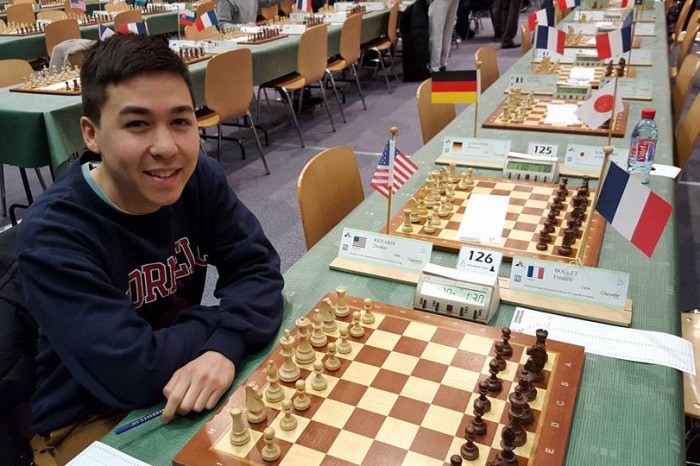 I’d like to show one of Tom’s most impressive games, especially since it was connected with a pretty funny story about opening preparation:
I’d like to show one of Tom’s most impressive games, especially since it was connected with a pretty funny story about opening preparation:
[pgn][Event "Cappelle La Grande"] [Site "?"] [Date "2016.02.19"] [Round "8"] [White "Belenkaya, Dina"] [Black "Riccardi, Thomas"] [Result "0-1"] [ECO "B40"] [WhiteElo "2346"] [BlackElo "2086"] [PlyCount "68"] [EventDate "2016.??.??"] 1. e4 c5 2. Nf3 e6 3. c4 Nc6 4. Nc3 Nd4 5. Nxd4 cxd4 6. Ne2 e5 7. Ng3 Nf6 8. Be2 h5 9. Bxh5 Nxh5 10. Nxh5 b5 11. cxb5 d5 12. Ng3 dxe4 13. Nxe4 Qd5 14. Qe2 f5 15. Ng3 d3 16. Qf3 e4 17. Qf4 Bd6 18. Qg5 Kf7 19. O-O Be7 20. Qe3 g5 21. b3 Kg6 22. Bb2 Bc5 23. Qe1 Bb7 24. Bxh8 e3 25. Ne4 Qxe4 26. f3 exd2+ 27. Qf2 Bxf2+ 28. Rxf2 Qe1+ 29. Rf1 Qe3+ 30. Rf2 Rxh8 31. Rd1 Rc8 32. Kf1 Rc1 33. Rfxd2 Rxd1+ 34. Rxd1 Qe2+ 0-1[/pgn]A few hours before the game, Tom showed me the idea of 8…h5, a novelty, with the point that after 9.Bxh5 Nxh5 10.Nxh5 b5! Black offers a second pawn and gets huge compensation with his powerful light-squared bishop. And of course this was exactly what transpired in the game, and Tom won beautifully against a titled opponent. But the real story begins about halfway through the game--I had already won and was observing Tom’s board, when Marc came up to me and started asking about Tom’s preparation, and if he had showed or mentioned his game to us against WGM Masha Klinova (Israel) from two rounds before. I had no idea what he was talking about, or why he was even asking, until he added that he had played that exact same line against his opponent:
[pgn]
[Event "Cappelle La Grande"]
[Date "2016.02.16"]
[Round "5"]
[White "Klinova, M."]
[Black "Esserman, M."]
[Result "0-1"]
[ECO "B40"]
[WhiteElo "2304"]
[BlackElo "2410"]
[PlyCount "54"]
[EventDate "2016.02.13"]
1. e4 c5 2. Nf3 e6 3. c4 Nc6 4. Nc3 Nd4 5. Nxd4 cxd4 6. Ne2 e5 7. Ng3 Nf6 8.
Be2 h5 9. Bxh5 Nxh5 10. Nxh5 b5 11. d3 Bb4+ 12. Kf1 g6 13. Ng3 bxc4 14. dxc4 a5
15. Bd2 Rb8 16. f3 Bc5 17. Rb1 d6 18. Qc2 Bd7 19. Ke2 Kf8 20. b3 Kg7 21. Be1 d5
22. cxd5 (22. exd5 f5 $40) 22... d3+ {White resigns--the final continuation
could be} 23. Kxd3 Bb5+ 24. Kd2 Be3+ $1 25. Kd1 (25. Kxe3 Qb6+ 26. Kd2 Qd4+ 27.
Kc1 Rbc8 $19) 25... Rc8 26. Qb2 Bd3 27. Ra1 Bd4 $19 0-1[/pgn]
So Marc too prepared the same crazy novelty and also ended up winning a nice game, although he couldn’t get his opponent to accept the second sacrificed pawn on b5. Interestingly, both Marc and Tom opted for the same psychological strategy during their games to “veil” their preparation, spending quite a bit of time in the opening stage, resorting to outright acting to make 8…h5 followed by 10…b5 appear completely improvised. While Marc’s opponent saw through the act and wisely rejected the second pawn, Tom’s victim bought his story and ended up paying the full price! In the end Marc finished with 6.5/9 and was again close to a GM norm. He also managed to score against another legend, Artur Yusupov, in a very interesting draw:
[pgn][Event "Cappelle La Grande"] [Date "2016.02.15"] [Round "3"] [White "Jussupow, Ar"] [Black "Esserman, M."] [Result "1/2-1/2"] [ECO "D46"] [WhiteElo "2578"] [BlackElo "2410"] [PlyCount "59"] [EventDate "2016.02.13"] 1. d4 d5 2. c4 e6 3. Nc3 c6 4. e3 Nf6 5. b3 Nbd7 6. Bb2 Bd6 7. Nf3 O-O 8. Bd3 Re8 9. Qc2 e5 10. cxd5 cxd5 11. dxe5 Nxe5 12. Nxe5 Bxe5 13. Ne2 d4 14. e4 Nxe4 15. Bxe4 d3 16. Bxd3 Bxb2 17. Bxh7+ Kh8 18. Qxb2 Bg4 19. f3 Qh4+ 20. Kf1 Qxh7 21. fxg4 Rac8 22. Rc1 Rxc1+ 23. Nxc1 Qe4 24. Qd2 Rc8 25. Ne2 Rc2 26. Qd8+ Kh7 27. Qh4+ Kg8 28. Qd8+ Kh7 29. Qh4+ Kg8 30. Qd8+ 1/2-1/2[/pgn]With Cappelle-la-Grande now finished Tom and I had just a single day to travel the entire length of France to the opposite corner, Cannes. FM Kostya Kavutskiy is a chess player, writer, and teacher based in Northern California. Make sure to follow Kostya on his Twitter and look for Part 2 of this article coming soon.
Categories
Archives
- December 2025 (19)
- November 2025 (29)
- October 2025 (39)
- September 2025 (27)
- August 2025 (29)
- July 2025 (43)
- June 2025 (25)
- May 2025 (24)
- April 2025 (29)
- March 2025 (29)
- February 2025 (20)
- January 2025 (24)
- December 2024 (34)
- November 2024 (18)
- October 2024 (35)
- September 2024 (23)
- August 2024 (27)
- July 2024 (44)
- June 2024 (27)
- May 2024 (31)
- April 2024 (51)
- March 2024 (34)
- February 2024 (25)
- January 2024 (26)
- December 2023 (29)
- November 2023 (26)
- October 2023 (37)
- September 2023 (27)
- August 2023 (37)
- July 2023 (47)
- June 2023 (33)
- May 2023 (37)
- April 2023 (45)
- March 2023 (37)
- February 2023 (28)
- January 2023 (31)
- December 2022 (23)
- November 2022 (32)
- October 2022 (31)
- September 2022 (19)
- August 2022 (39)
- July 2022 (32)
- June 2022 (35)
- May 2022 (21)
- April 2022 (31)
- March 2022 (33)
- February 2022 (21)
- January 2022 (27)
- December 2021 (36)
- November 2021 (34)
- October 2021 (25)
- September 2021 (25)
- August 2021 (41)
- July 2021 (36)
- June 2021 (29)
- May 2021 (29)
- April 2021 (31)
- March 2021 (33)
- February 2021 (28)
- January 2021 (29)
- December 2020 (38)
- November 2020 (40)
- October 2020 (41)
- September 2020 (35)
- August 2020 (38)
- July 2020 (36)
- June 2020 (46)
- May 2020 (42)
- April 2020 (37)
- March 2020 (60)
- February 2020 (38)
- January 2020 (45)
- December 2019 (34)
- November 2019 (35)
- October 2019 (42)
- September 2019 (45)
- August 2019 (56)
- July 2019 (44)
- June 2019 (35)
- May 2019 (40)
- April 2019 (48)
- March 2019 (61)
- February 2019 (39)
- January 2019 (30)
- December 2018 (29)
- November 2018 (51)
- October 2018 (45)
- September 2018 (29)
- August 2018 (49)
- July 2018 (35)
- June 2018 (31)
- May 2018 (39)
- April 2018 (31)
- March 2018 (26)
- February 2018 (33)
- January 2018 (30)
- December 2017 (26)
- November 2017 (24)
- October 2017 (30)
- September 2017 (30)
- August 2017 (31)
- July 2017 (28)
- June 2017 (32)
- May 2017 (26)
- April 2017 (37)
- March 2017 (28)
- February 2017 (30)
- January 2017 (27)
- December 2016 (29)
- November 2016 (24)
- October 2016 (32)
- September 2016 (31)
- August 2016 (27)
- July 2016 (24)
- June 2016 (26)
- May 2016 (19)
- April 2016 (30)
- March 2016 (36)
- February 2016 (28)
- January 2016 (32)
- December 2015 (26)
- November 2015 (23)
- October 2015 (16)
- September 2015 (28)
- August 2015 (28)
- July 2015 (6)
- June 2015 (1)
- May 2015 (2)
- April 2015 (1)
- February 2015 (3)
- January 2015 (1)
- December 2014 (1)
- July 2010 (1)
- October 1991 (1)
- August 1989 (1)
- January 1988 (1)
- December 1983 (1)


